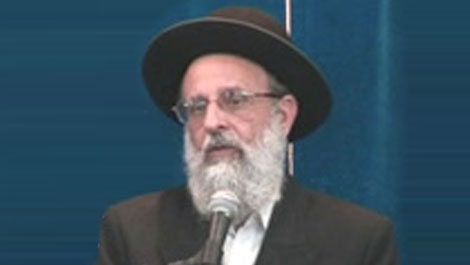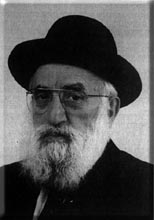Beit Midrash
- Jewish Laws and Thoughts
- Jewish Laws and Customs
- Various Subjects
Although the use of techeiles stopped over a thousand years ago, there have been a few attempts within the last 130 years to reintroduce the practice of wearing techeiles threads alongside the white threads. This article will present the differing opinions on this question and some of the issues that have been raised.
At the time of the Gemara, the nature of chilazon and its manufacture was still known and practiced (see Menachos 42b). However, some time after the period of the Gemara, the use of techeiles ended. By all indications, techeiles fell into disuse sometime between the end of the period of the Rabbonim Saborayim who completed the editing of the Gemara around the year 4330 (570) and the time of Rav Ahai Gaon, the author of the She’iltos, around 4520 (760).
It is unclear why the Jewish people stopped using techeiles. Numerous theories have been suggested why wearing techeiles ended. The wording used by the midrashim is "now we have only white tzitzis since the techeiles was concealed" (Medrash Tanchuma, Shlach 15; Medrash Rabbah, Shlach 17:5). Some poskim understand that there are halachic or kabbalistic reasons why techeiles should not be worn until moshiach comes (Shu"t Yeshuos Malko #1-3). According to this opinion, the Medrash means that the source of the techeiles was concealed and it is only to be revealed in the future at a time when Hashem again wants us to wear it again.
Other poskim disagree and contend that we should still attempt to fulfill the mitzvah of wearing techeiles on the tzitzis. They explain that the Medrash means that techeiles became unavailable. Rav Herzog zt"l, who followed this approach, speculated that persecution by anti-Semitic governments ended the production of techeiles. Still another possibility is that the knowledge how to produce the techeiles was lost, or that there was no longer availability or access to the chilazon, the source of the techeiles.
The Radziner Rebbe’s Research and Conclusion
In 5647 (1887), the Radziner Rebbe, Rav Gershon Henoch Leiner, zt"l, published a small sefer, Sefunei Temunei Chol, wherein he discusses the importance of fulfilling the mitzvah of wearing techeiles even today. In his opinion, the Medrash quoted above means that techeiles became unavailable, not that we are not permitted to wear techeiles. The Radziner encouraged wearing something that might be techeiles even if it there is some question as to whether one is indeed fulfilling the mitzvah. In his opinion, one who is wearing questionable techeiles should do so, because maybe he is fulfilling a mitzvah min hatorah. Thus, he contended that if he could identify a species that might be the chilazon, and he could extract a dye from it, then one should wear tzitzis that are dyed this way.
The Radziner himself analyzed every place in the Gemara where the word chilazon is mentioned and defined what characteristics would help us identify the chilazon. Based on his analysis, he drew up a list of eleven requirements with which one could identify the chilazon. Among other requirements, these included that the chilazon would be located in the eastern Mediterranean Sea; that it is a marine animal and not a fish; that it must be able to live on land at least for a brief period of time; that it produces a black ink and that it must have fins, bones, and sinews. The Radziner concluded that if one located a marine animal that meets all these requirements, one can assume that it is the chilazon.
Having completed his halachic research, the Radziner then began his scientific research to identify the chilazon. He traveled to Naples, Italy, to study marine animals that would meet all the requirements of techeiles. In Italy, he decided that the cuttlefish, which in many languages is called an inkfish, is indeed the chilazon from which one produces techeiles. The cuttlefish meets every one of the Radziner’s requirements for chilazon, including that it emits a dark dye, which is the reason why it is called an inkfish. The cuttlefish is not a true fish and is capable of living on land for brief periods of time.
The Radziner then published his second volume on the subject, Pesil Techeiles, in which he announced his discovery of the chilazon and all his proofs why the cuttlefish meets all the requirements of the chilazon. Subsequently, the Radziner published a third volume, Ayn HaTecheiles whose purpose was to respond to all the questions he has been asked on his previous volumes.
Reaction to the Radziner’s Proposal
Although the Radziner had presented his case in an extremely convincing manner, most of the Gedolei Yisroel did not support his theory. Ayn HaTecheiles was published by the Radziner to refute those who had disagreed with him and to attempt to convince others of the validity of his approach. He attempted to get several great poskim to agree with him, particularly, Rav Yitzchok Elchonon Spector (the Rav of Kovno and the Posek HaDor at the time), the Beis HaLevi (then the Rav of Brisk), Rav Yehoshua Kutno (author of Yeshuos Malko, the Rav of Kutno and considered one of the Poskei HaDor), the Maharil Diskin (who had been Rav of Brisk and was living in official retirement in Yerushalayim), and Rav Shmuel Salant (the Rav of Yerushalayim). None of these Rabbonim accepted the Radziner’s proposal. Their reasons for rejecting his proposal are significant.
Counter Arguments
Rav Yehoshua Kutno and Rav Yitzchok Elchonon disagreed with the Radziner for a different reason. In their opinion, the Medrash quoted above should be understood literally, meaning that techeiles had been placed in genizah until Hashem again wants us to observe this mitzvah. Rav Yehoshua Kutno suggests several reasons why this happened, reasons that are beyond the scope of this article.
Others were opposed to wearing techeiles because of sources in the writings of the Ari and other mekubalim that say that we are not to use techeiles until the rebuilding of the Beis HaMikdash, bimheira biyameinu. The Radziner did not agree with their interpretation of these sources.
An additional objection was raised against the Radziner’s position that one should wear questionable techeiles since one might be fulfilling the mitzvah. This is based on the poskim who contend that one who places blue tzitzis that are dyed with a dye other than techeiles on a white garment is not yotzay the mitzvah. Therefore, it is preferable to wear white tzitzis if one is uncertain (see Rama, Orach Chayim 9:5).
There were also objections to the Radziner’s conclusions on other grounds. Some objected to his choosing a non-kosher species as the source or the techeiles since there are early poskim who contend that the techeiles must come from a kosher species. Others contend that the color of the Radziner’s techeiles was wrong, since Rashi states that the techeiles is green.
On the other hand, there were some Gedolim that considered the merits of the Radziner’s position. The Maharsham wore a talis with the Radziner’s techeiles, although apparently he did so only in private. However, in the final result only the Radziner’s own chassidim and some Breslever Chassidim wear the techeiles that the Radziner introduced.
Rav Herzog’s Research
More than twenty years after the Radziner’s passing, Rav Herzog (later to become the first Chief Rabbi of Israel) researched the source for the techeiles. In his analysis of the halachic issues involved, Rav Herzog accepted most of the Radziner’s opinions and interpretations. However, there are some aspects of the Radziner’s approach with which Rav Herzog took issue. Whereas the Radziner assumed that every place in the Gemara where it refers to chilazon, it means the chilazon that was used in making techeiles, Rav Herzog assumes that chilazon means a sea snail, and not necessarily the snail used in making the techeiles. Thus, in Rav Herzog’s opinion, not all of the Radziner’s requirements in determining the species for the techeiles are accurate. Therefore, Rav Herzog focused on determining among the numerous species of sea snails which ones are the most likely candidates to be the chilazon that was specifically used for producing techeiles dye.
There is one major point of the Radziner’s conclusions with which Rav Herzog took issue. Rav Herzog took samples of the dye recommended by the Radziner as techeiles and had them chemically tested. Based on results that he received from the laboratories, Rav Herzog concluded that the blue color that results from the Radziner’s techeiles are not caused by anything in the cuttlefish ink. The chemists he consulted contended that the color is an artificial dye named Prussian blue which was created by the chemicals added as part of the processing. In Rav Herzog’s opinion, since he could not discern anything in the cuttlefish that causes the blue coloring, he reaches the conclusion that the cuttlefish could not possibly be the source of the techeiles. (There are answers to explain how the Radziner might have responded to this question that are beyond the scope of this article.)
Rav Herzog conducted much research on which sea snail is the most likely source for techeiles. However, in his conclusion he rejects each of these species because they do not meet all the requirements listed by the Gemara and Rambam. Thus, after much scientific and halachic research, Rav Herzog did not have a source of techeiles to recommend. Furthermore, it should be noted that all the poskim who disagreed with the Radziner’s proposal, as recorded in Ayn HaTecheiles, would all disagree with Rav Herzog’s proposals.
Recently, some have attempted to answer the questions raised by Rav Herzog. These researchers have suggested that one of the species of sea snail named murex trunculus might indeed be the source for techeiles. Rav Herzog rejected this species as the source for techeiles for several reasons that these researchers feel that they have resolved. (See also what he wrote years later in Ha’Ir HaKodesh ViHamikdash Volume 4: Section 5: Chapter 6.) These researchers have formed an organization that encourages the wearing of tzitzis dyed with murex trunculus extract as a fulfillment of the mitzvah of wearing techeiles.
It should be noted that the method currently used to process the dye from the murex trunculus cannot be the method used in the days of Chazal of dyeing techeiles threads. This is for the following reasons:
1. The current method of extracting dye from murex trunculus involves removing a gland from the snail, which would involve the melacha of gozeiz, removing part of a living creature. (According to many poskim, one violates this also by removing part of a creature that has since died.) Clearly, this could not have been the method of removing the dye from chilazon in earlier days, as can be proved from the Gemara (Shabbos 75a) since no mention is made of this prohibition in the Gemara, although it mentions other prohibitions.
2. Another objection is based on the fact that it can be demonstrated from the Gemara that the removing of the dye liquid from the chilazon kills it, although one would prefer that the chilazon remain alive for as long as possible. However, in the process used to remove the dye from murex, the snail can remain alive for several hours after the process is complete.
Neither of these problems necessarily disproves murex trunculus as the source of techeiles; they simply demonstrate that the current method is not the one used by Chazal. It might be true that there is an alternative method for extracting techeiles that was discovered today that was not used in the days of Chazal for some unknown reason.
3. A third problem with the current method of using murex trunculus requires an introduction. At the time of the Gemara, there were unscrupulous individuals who sold threads dyed with a coloring called kla ilan. This coloring is not kosher as techeiles and therefore someone wearing it on his tzitzis would not fulfill the mitzvah of wearing techeiles. According to the Aruch, kla ilan is indigo, a vegetable dye that has a blue color. Thus, the Gemara was concerned about someone selling indigo-colored threads as techeiles threads to an unsuspecting buyer. The Gemara describes a test that can be used to check whether the threads are kla ilan or techeiles, by testing the threads for colorfastness, whereby kla ilan would fade, whereas techeiles would remain fast. However, if the dye produced from murex trunculus is indigo, and the substitute is also indigo, how could a chemical test for colorfastness be used to determine what was the source of the indigo?
4. The Rambam (Hilchos Tzitzis 2:2) describes that the "blood" that is the source of the techeiles is black like ink. This indeed was one of the reasons why the Radziner considered the cuttlefish to be the source of techeiles, since its "ink" is black. However, the gland extract removed from murex trunculus is clear when removed and only changes color afterwards.
Obviously, I am not the first one to note these difficulties with the process of extracting dye from murex trunculus. However, the responses I have seen to answer these questions are very tenuous.
We see that there has been a significant amount of research about the source of techeiles and the possibility of fulfilling this mitzvah in our day. Due to the above mentioned considerations, we see that those who follow the approach of the majority of the poskim of earlier generations and wear only white tzitzis have a substantive basis in halacha.
This Shiur is published also at Rabbi Kaganof's site

When is it not Shatnez? Part II
Rabbi Yirmiyohu Kaganoff | Iyar 10 5780

Using Dishes of Unknown Type
Rabbi Daniel Mann | Tammuz 5783
The Woman and Her Commandments
Rabbi Eliezer Melamed | 5766























